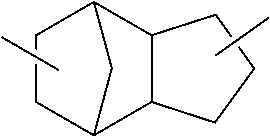Photochromic curable composition
a curable composition and photochromic technology, applied in the field of photochromic curable compositions, can solve the problems of difficult to achieve the photochromic properties required for photochromic eyeglass lenses, unsatisfactory adhesion between the photochromic coating layer and the hard coat layer, and the storage stability of the photochromic curable composition may degrade, etc., to achieve excellent photochromic properties, high color optical density, and high fading speed
- Summary
- Abstract
- Description
- Claims
- Application Information
AI Technical Summary
Benefits of technology
Problems solved by technology
Method used
Image
Examples
example 1
[0175]3 parts by mass of PC1 as a photochromic compound was added to and fully mixed with 100 parts by mass of (meth)acrylic polymerizable monomers consisting of 50 parts by mass of BPE500 having methacrylic groups, 30 parts by mass of TMPT having methacrylic groups and 17 parts by mass of 9GA having acrylic groups as the polyfunctional polymerizable monomers (Ia) and 3 parts by mass of GMA having a methacrylic group as the monofunctional polymerizable monomer (Ib) to obtain a photochromic curable composition. The total content of the polyfunctional polymerizable monomers (Ia) in the (meth)acrylic polymerizable monomers of this photochromic curable composition was 97 mass % and the number of moles of the methacrylic group existent in the (meth)acrylic polymerizable monomers was 6.3 times the number of moles of the acrylic group. 5 parts by mass of LS765 as an light stabilizer, 3 parts by mass of IRGANOX245 as an antioxidant and 0.5 part by mass of CGI1800 as a polymerization initiat...
examples 2 to 13
[0179]The operation of Example 1 was repeated to evaluate the physical properties except that the photochromic curable compositions shown in Tables 1 to 3 were used. The results are shown in Table 4. As shown in Table 4, good results were obtained for all the properties.
[0180]Even when the same evaluations were made on the above photochromic curable compositions which had been put in a brown glass container and kept at 40° C. for 3 months, good results were obtained for all the properties.
TABLE 1Value obtained bydividing the number ofPolymerizable monomersmoles of methacrylicPolymerizablePolymerizablegroup by the number ofmonomers havingmonomers havingPhotochromicmoles of acrylic groupEx.methacrylic group(s)acrylic group(s)compoundexistent inNo.(parts by mass)(parts by mass)(parts by mass)polymerizable monomers1monofunctionalGMA(3)—PC3(3)6.3difunctionalBPE500(50)9GA(17)trifunctionalTMPT(30)—2monofunctionalGMA(5)—PC3(3)3.9difunctionalBPE500(45)9GA(25)trifunctionalTMPT(25)—3monofuncti...
PUM
| Property | Measurement | Unit |
|---|---|---|
| mass % | aaaaa | aaaaa |
| mass % | aaaaa | aaaaa |
| mass % | aaaaa | aaaaa |
Abstract
Description
Claims
Application Information
 Login to View More
Login to View More - R&D
- Intellectual Property
- Life Sciences
- Materials
- Tech Scout
- Unparalleled Data Quality
- Higher Quality Content
- 60% Fewer Hallucinations
Browse by: Latest US Patents, China's latest patents, Technical Efficacy Thesaurus, Application Domain, Technology Topic, Popular Technical Reports.
© 2025 PatSnap. All rights reserved.Legal|Privacy policy|Modern Slavery Act Transparency Statement|Sitemap|About US| Contact US: help@patsnap.com



